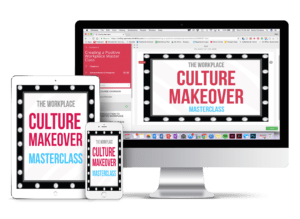One perpetual problem HR professionals seem to face is convincing the boss to invest in them and their ideas. We hear it all the time, “Let’s get HR a seat at the table.” To convince your boss to invest in your ideas, you have to demonstrate the benefits and persuade the boss it’s worth the time and money. Money talks, as they say.
I’ve had to get good at helping my potential clients – HR professionals who call me for help with their culture – sell culture change to their bosses. I often share these four steps with them to help them get through to their bosses:
Step 1. Review the program you want your boss to invest in.
Select the portions of the course that are most beneficial to you and your company, and then be prepared to be specific with your boss about how and why those specific portions are paramount for the organization. For example, if you were going to convince your boss to invest in my eight-module online learning course about culture change, you might share with him or her that turnover is high and the survey you’ll be able to send out to the workforce as a result of the course will help you understand why. Add in that turnover costs about 30% of the exiting employee’s annual salary, and the course pays for itself if you save even one employee.
Step 2. Stress the value of investing in the course.
The smarter you are, the better you are for the organization. In addition, if you can point out stats and facts related to the course topic, that can help you too. For example, here’s an article from inside my eight-module workplace culture course to help you make the point that employee engagement really does increase performance. There’s an ROI to engagement, and your boss will need to understand that if you wanted him or her to give you some budget for my course.
Step 3. Write the perfect email laying out your request.
The formula for your request email is as follows:
- State the name of the course and that it will be critical for you and the organization
- Describe the course offerings and what you will learn / what actions you will be able to take a result of the course
- Share the price and why that price is worth it / offer an ROI for the course (e.g., if just one person is saved from quitting, the course will have paid for itself)
- Describe the qualifications of the instructor or company offering the course
- State your case about how investment in the course will pay off
- Offer to meet with your boss during or after the course to discuss everything you’re learning and how you will apply it directly to your organization
I wanted to help you out, so I created an email template for you to use. I used my Workplace Culture Makeover Masterclass as an example but you can tailor it to match your needs! Convince your boss to invest in you.
Step 4. Meet with your boss throughout the course.
Share what you are learning, what the action steps are, and what you need from the boss for support.
In the end…
For years, HR has struggled to be taken seriously as a leader in organizations. They have been excluded from meetings, brushed off, and left to their own devices. The problem with that is that human resources is vital to organizational success. They are the connection to the greatest and most expensive assets a company invests in – employees. As a strategic partner to the organization, HR is the captain of building a positive culture where employees can thrive. A positive culture means engaged employees, which means higher financial performance, better productivity, and lower turnover rates. In other words, HR has a major impact on the bottom line. No longer should HR be sent off to their office to take employee complaints and run payroll. They should be sitting down at those leadership meetings and saying, “here is what we need to do to make sure our organization is a success.” It’s time to stop asking for a seat at the table and take it.
You got this,
Catherine.
**P.S. Click here if you want to learn more about my Workplace Culture Makeover Masterclass, an 8-module online learning program for HR professionals, leaders or consultants who want to create a positive and thriving work environment.




